Warning: pic heavy as usual. 
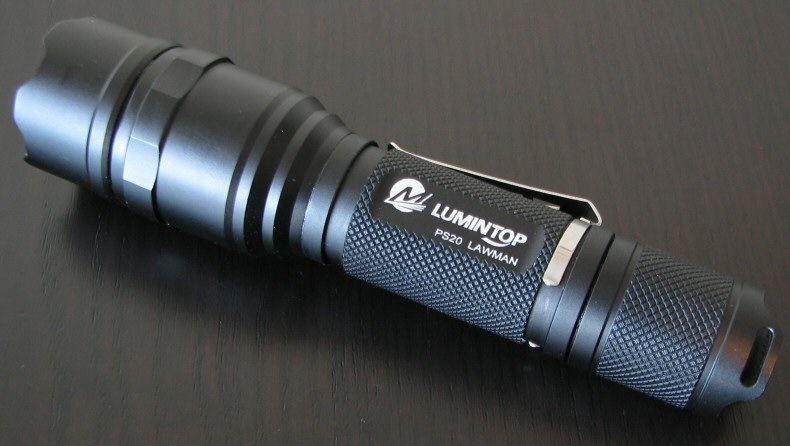
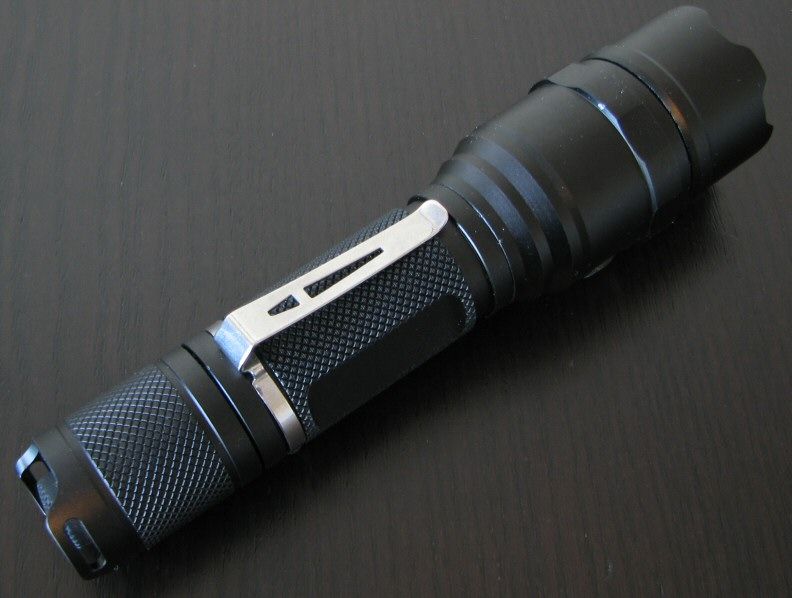
This review is of an engineering sample of a new dual-switch Lumintop light, the PS20 "non-polar" Lawman. The "non-polar" refers to the ability of the light to function with batteries loaded in any orientation. The light is clearly marketed to the law-enforcement/tactical crowd. Read on to find out if it is a fit …
Manufacturer Reported Specifications:
Note: as always, these are only what the manufacturer reports. To see my actual testing results, scroll down the review.
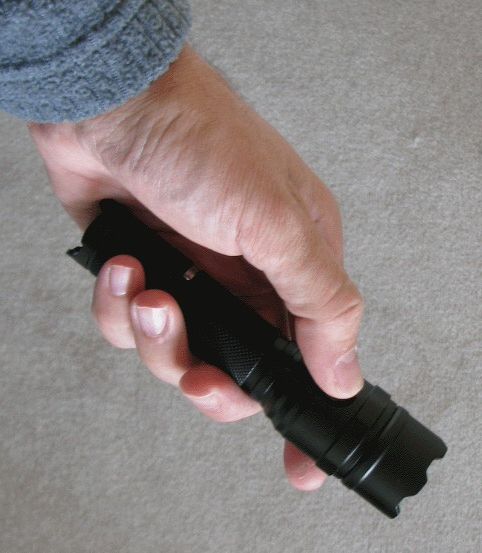
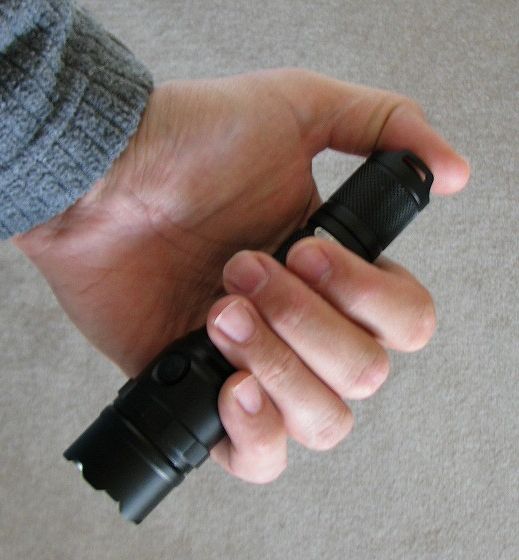
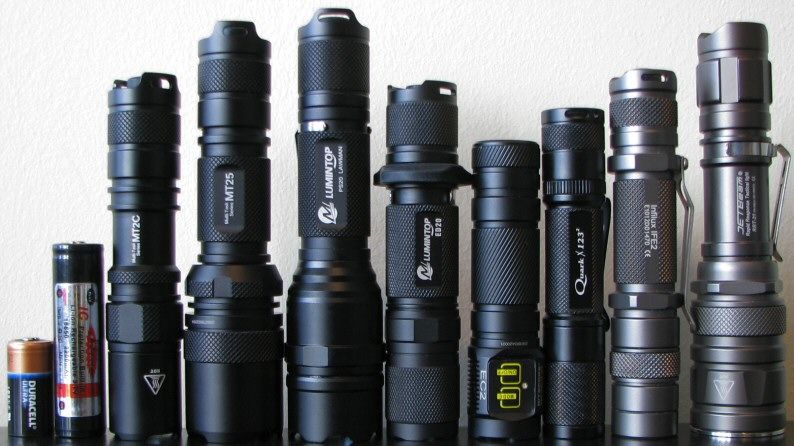
From left to right: CR123A; AW Protected 18650; Nitecore MT2C, MT25; Lumintop PS20, ED20; Nitecore EC2; Quark Q123-2; Nitecore IFE2; Jetbeam RRT-21.
All dimensions are given with no batteries installed:
Lumintop PS20: Weight 118.6g, Length: 146.6mm, Width (bezel): 33.1mm, (widest): 35.1mm
Nitecore MT2C: Weight: 75.9g, Length: 125.3mm, Width (bezel): 25.5mm
Nitecore MT25: Weight 124.6g, Length: 142.9mm, Width (bezel): 34.2mm
Eagletac D25LC2: Weight: 50.0g, Length: 116.3mm, Width (bezel): 22.5mm
Foursevens Quark Q123-2-X (Regular tailcap): Weight: 44.6g, Length: 112.7mm, Width (bezel) 22.0mm
Klarus XT11: Weight 133.0g, Length: 148.8, Width (bezel) 35.0mm
Sunwayman V20C: Weight: 117.4g, Length 133.0mm, Width (bezel) 32.2mm
Thrunite TN10: Weight: 154.7g, Length: 145.5mm, Width (bezel): 35.1mm
Zebralight SC600: Weight 87.2g, Length: 107.8mm, Width (bezel) 29.7mm
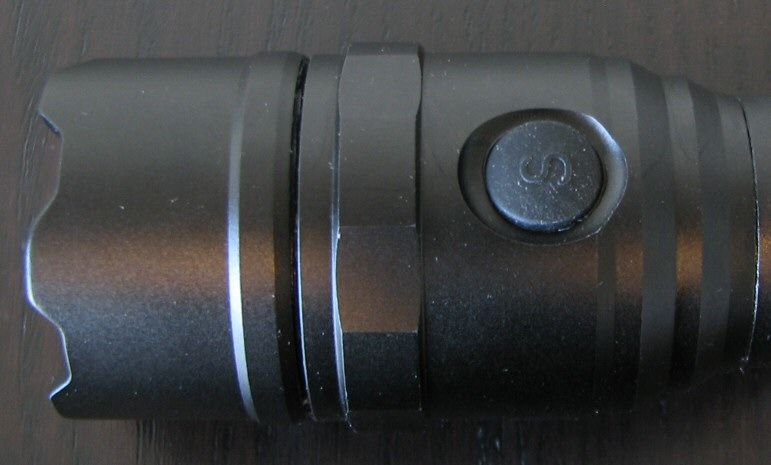
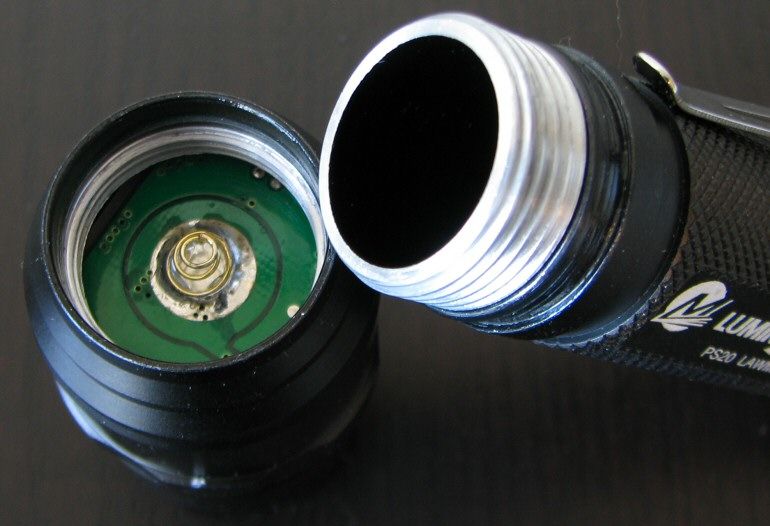
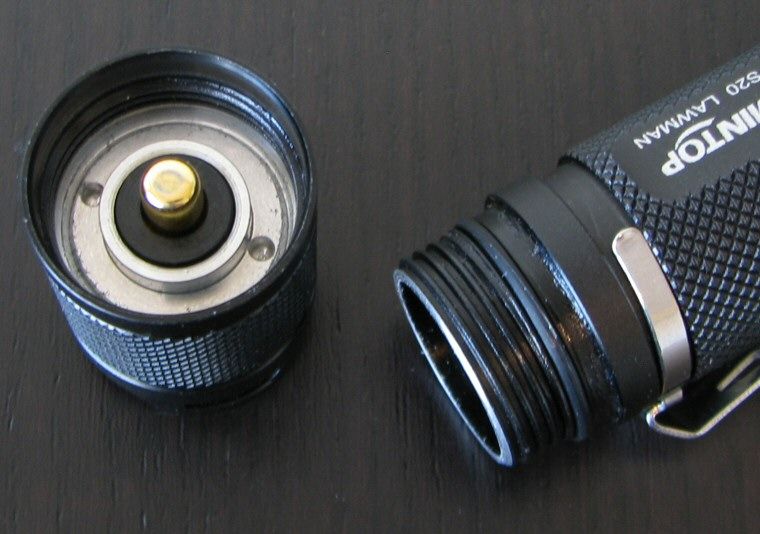
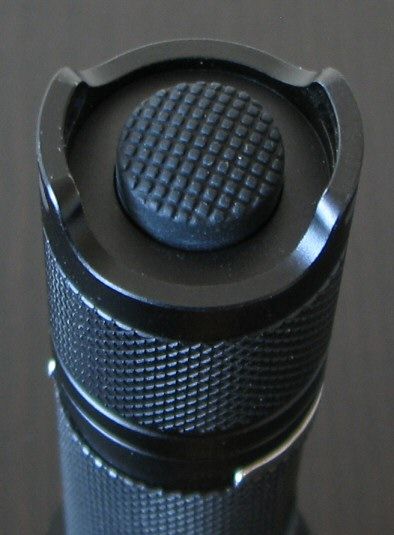
Anodizing is a matte black, with no chips on my samples. Labels are bright white, clearly legible against the dark background. There is knurling across the tailcap and battery tube and head, of reasonable aggressiveness. Grip seems good.
Distinctive to this model is the dual-switch design, with the secondary switch in the head (with a small "S" label). Interesting note – the tailcap is NOT a physical clicky switch, but an electronic one. Both switches have a fairly typical electronic feel. See my User Interface discussion below for more info on how this all works.
Also an interesting feature – the light can work with a battery in either polarity orientation. This is certainly novel – no risk of damaging the light.
There is a spring on the contact board in the head, so flat top cells can be used. The body tube is wide enough to take high-capacity protected 18650 cells. :thumbsup:
The light come with a fairly typical removable pocket clip. Nothing fancy here.
Screw threads are standard triangular cut, and seem of good quality. They are also anodized for lock-out at the tailcap.
Light can tailstand stably.
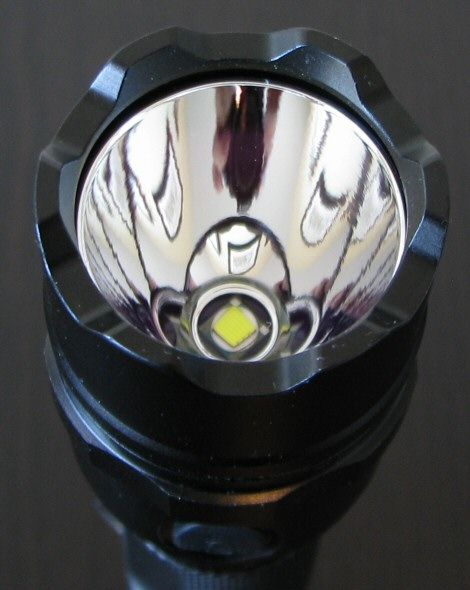
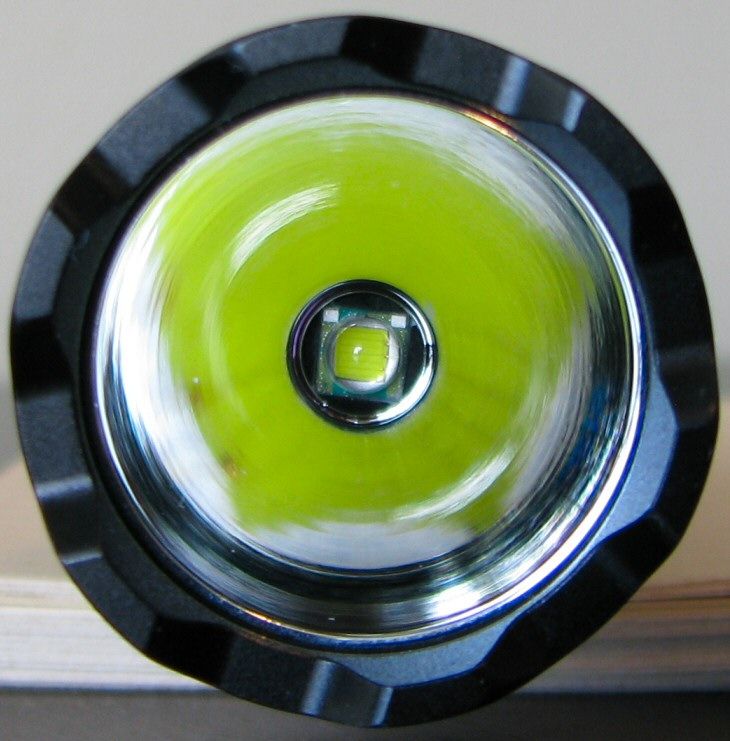
Light came with a cool white emitter on my sample, reasonably well centered. Reflector was smooth finish, and fairly deep.
User Interface
The user interface is fairly unique on the PS20.
Press on the rear tailcap switch, to turn the light on or off. "Off" is this context is actually a Standby mode. Switch is an electronic switch, and a simple press-and-release acts like a reverse clicky switch.
Mode switching is controlled by the switch near the head. Press-and-release to switch modes. Mode sequence is Hi > Lo > Strobe > Standby, in repeating sequence. There is no mode memory, and light always comes back on in Hi when coming off of Standy (from either switch).
This is definitely a more tactical interface, as the light always comes on in Hi. However, Strobe can only be accessed by going through Lo first.
An interesting feature – the light works with the battery inserted in either polarity. So no worries about accidentally inserting the battery the wrong way.
For more information on the light, including the build and user interface, please see my new video overview:
As always, videos were recorded in 720p, but YouTube typically defaults to 360p. Once the video is running, you can click on the configuration settings icon and select the higher 480p to 720p options. You can also run full-screen.
PWM/Strobe/Standby
I am unable to detect any signs of PWM on either Lo or Hi using my standard soundcard oscilloscope. Either the light is current-controlled, or it uses PWM at too high a frequency for me to detect. Either way, there is no sign of flicker visually.
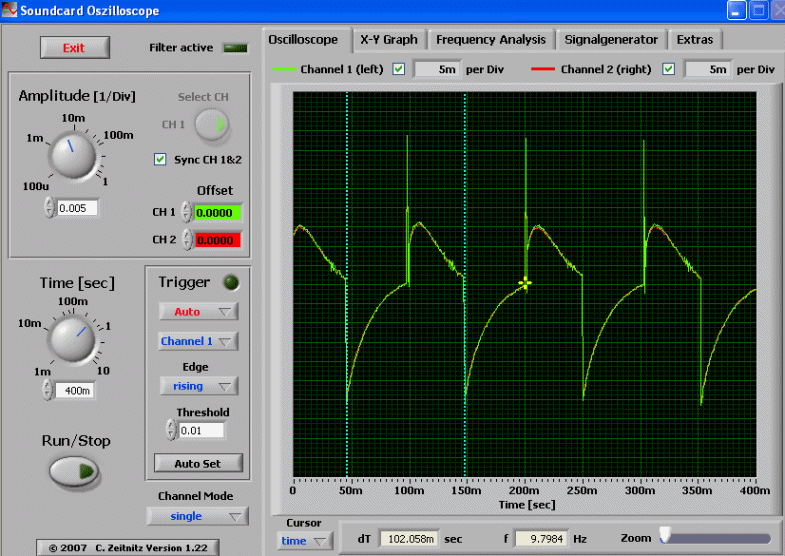
Strobe is fairly standard ~10 Hz.
Due to electronic switch design, the PS20 has a small current draw when in "Standby" mode (i.e., tailcap connected, but with no light being produced). On a 3.7V 18650, I measured this current as 3.6mA. That means a fully-charged 2600mAh 18650 battery would be completely drained in 30 days. As such, I recommend you store the light locked out at the tailcap when not in use.
Beamshots:
All lights are on Max output on 1x AW protected 18650 (2200mAh). Lights are about ~0.75 meter from a white wall (with the camera ~1.25 meters back from the wall). Automatic white balance on the camera, to minimize tint differences.
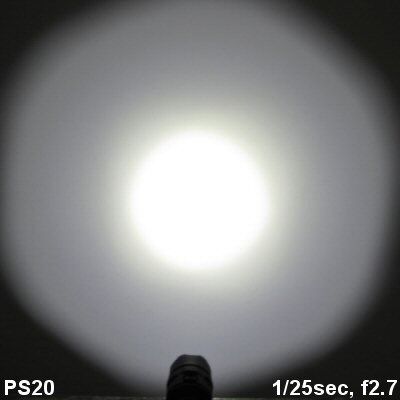
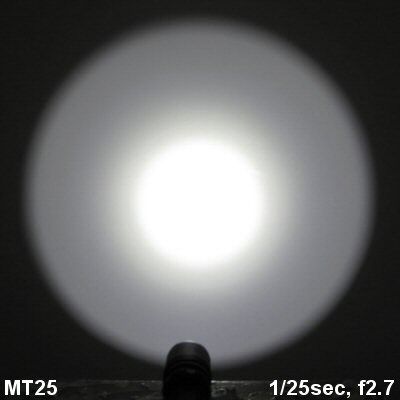
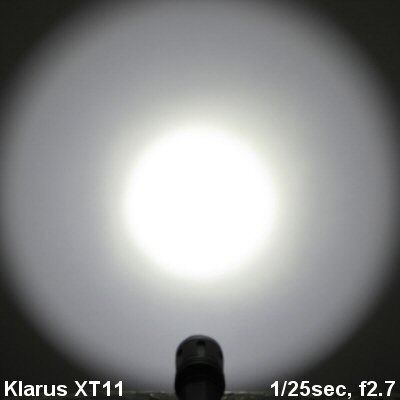
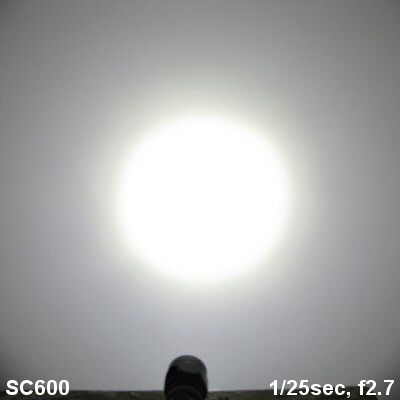
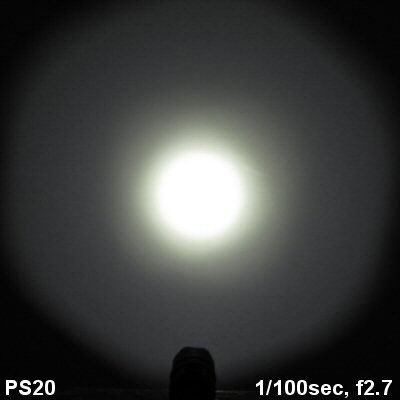
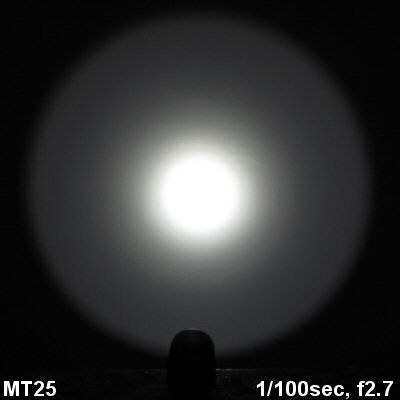


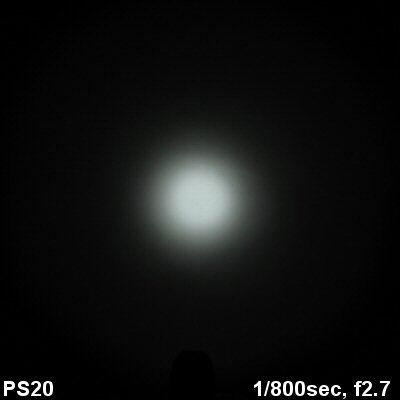
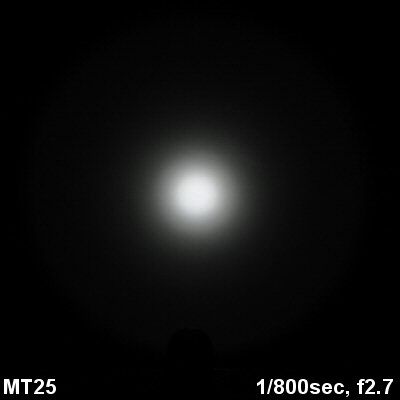
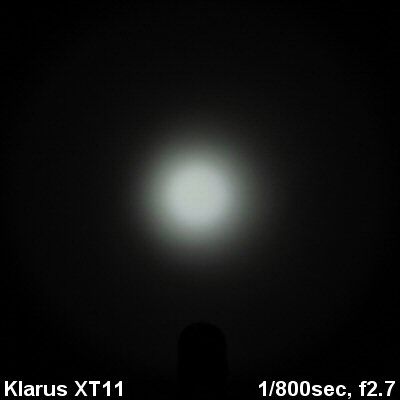
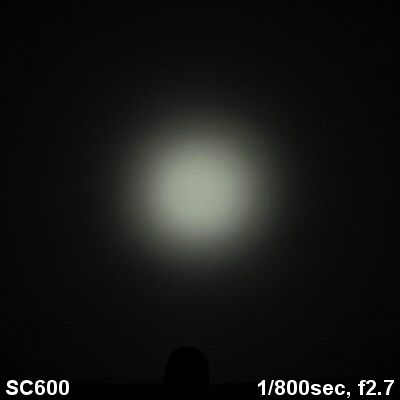
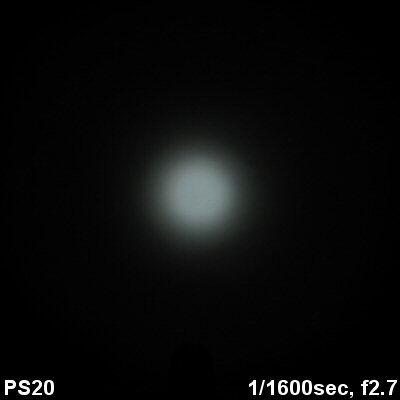
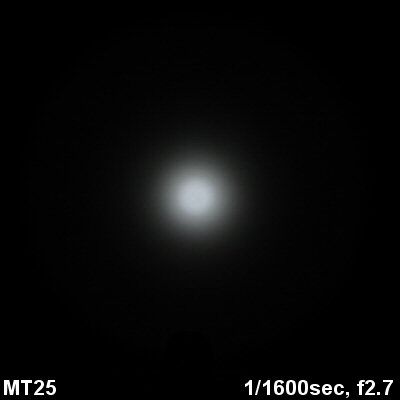
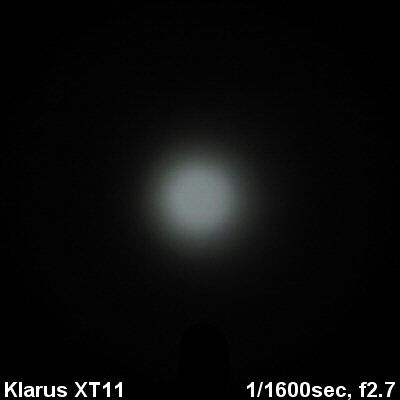
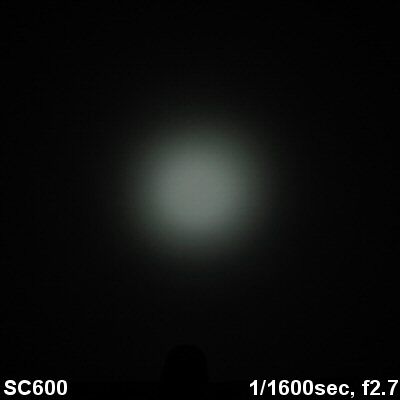
Testing Method:
All my output numbers are relative for my home-made light box setup, a la Quickbeam's flashlightreviews.com method. You can directly compare all my relative output values from different reviews - i.e. an output value of "10" in one graph is the same as "10" in another. All runtimes are done under a cooling fan, except for any extended run Lo/Min modes (i.e. >12 hours) which are done without cooling.
I have devised a method for converting my lightbox relative output values (ROV) to estimated Lumens. See my How to convert Selfbuilt's Lightbox values to Lumens thread for more info.
Throw/Output Summary Chart:
My summary tables are reported in a manner consistent with the ANSI FL-1 standard for flashlight testing. Please see http://www.flashlightreviews.ca/FL1.htm for a discussion, and a description of all the terms used in these tables.

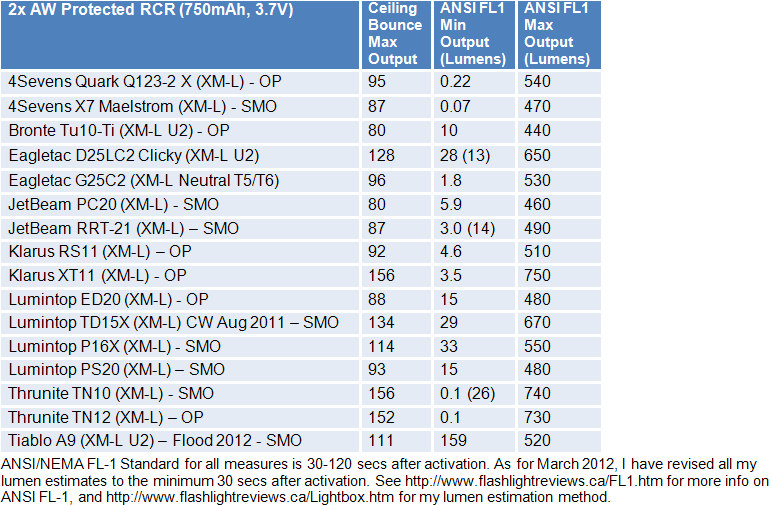
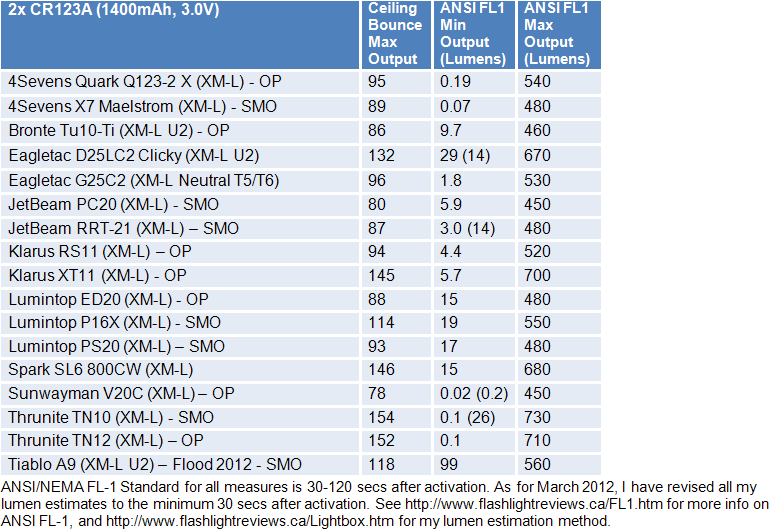
Throw is reasonably good for the class – very similar to the Klarus light in this size.
The overall output level on Hi is reasonable, although I would have personally preferred a Med mode somewhere between the Lo and Hi levels.
The PS20 is very consistent in output on all battery types tested (1x18650, 2xCR123A and 2xRCR).
Output/Runtime Comparison:
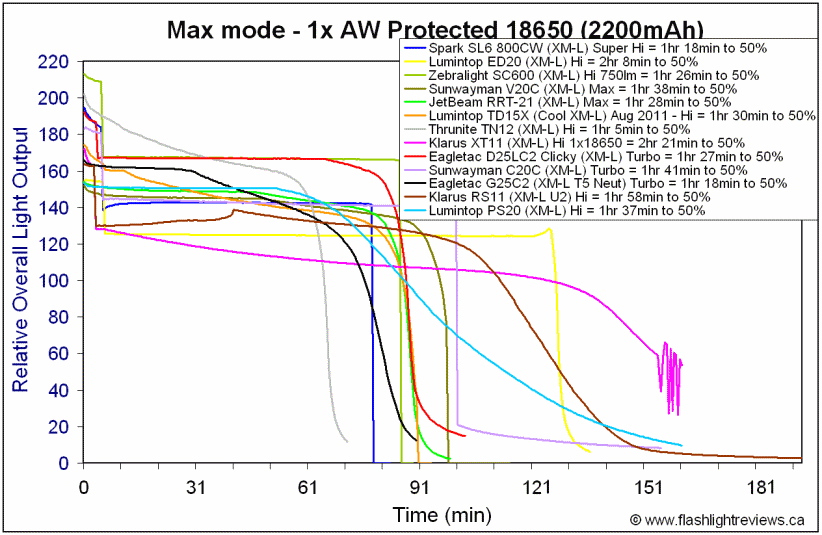
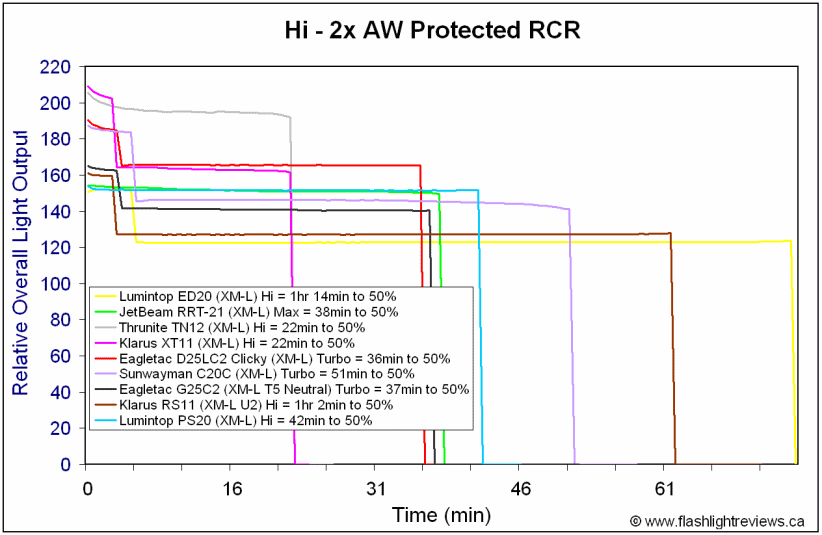
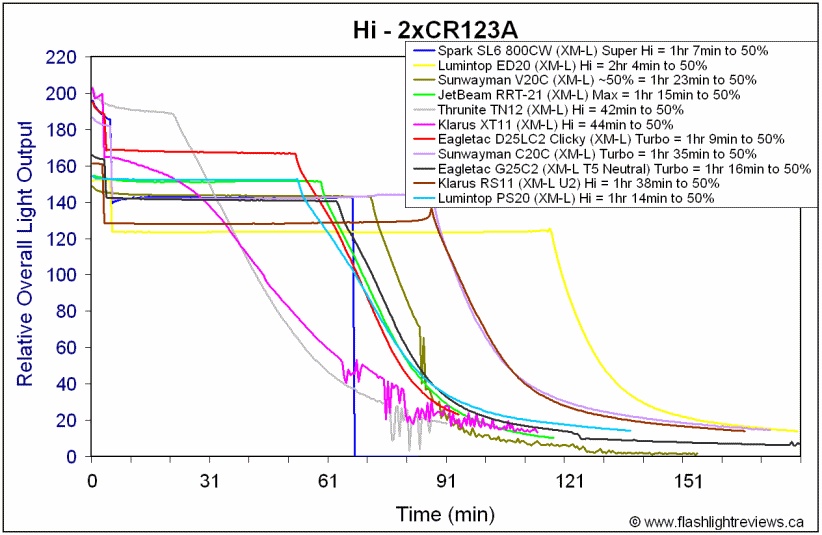
The PS20 on Hi is very much in keeping with other lights of this class. Note the presence of the T6 output bin here (most of the other XM-L lights in my graphs are U2 output bin). Regulation pattern is very flat on all cells.
I haven't tested the Lo mode, as I would expect a couple of days runtime at that <20 lumen level
Potential Issues
Light lacks a memory mode, and always comes on in Hi (intentional, to appeal to the tactical audience). However, mode sequence requires you to go through Lo before Strobe (and thus also has Strobe on the main sequence).
The light has a low mA standby drain when connected (3.6mA on 3.7V 18650). This is sufficient to fully drain a 2600mAh 18650 in one month. As such, I recommend you lock out the light when not in use.
On my sample, there was a messy soldering job for the spring on the postive contact board in the head.
The light lacks a defined Med mode.
Preliminary Observations
In terms of build, the PS20 "Lawman" looks very much in keeping with others of this class (particularly so for dual-switch models). It feels solid and robust in the hand, with a fairly typical look and feel. Overall grip is good, although the knurling could be more aggressive.
Where things get more interesting is in the dual-control interface. Despite how the tailcap looks, there is no physical clicky switch. The light has electronic switches at both ends, with a fairly standard electronic switch feel.
Operation is diffirent than the Spark lights, where the dual switches perform the same function. Here, the tailcap electronic switch turns the light on/off, while the secondary switch in the head controls modes. Note that both switches are programmed to function as "reverse clickies" (i.e., the state or mode change occurs only after you release the switch following a press). Interestingly, both switches have a standy "off" state (i.e., rear is On > Off, etc, and the front is Hi > Lo > Strobe > Off, etc.).
The light always comes on in Hi first, which is clearly designed to appeal to the tactical "lawman" crowd. Lumintop highlights this issue in its marketing material, along with the completely silent switch operation. This later point I've always found be a rather dubious benefit, given that nearly 500 lumens are about to come pouring out of the light immediately after a button press (i.e., that's pretty much bound to dispel any "tactical" benefit of silent operation pretty quickly). Of course, my only personal "tactical" need is to avoid stepping on the cat in the middle of the night, so maybe I am missing something here. But I would have thought "forward clicky" programming would be more popular (i.e., tactical folk seem to like an instant-access momentary mode, as well as constant on). :shrug:
Of course, my only personal "tactical" need is to avoid stepping on the cat in the middle of the night, so maybe I am missing something here. But I would have thought "forward clicky" programming would be more popular (i.e., tactical folk seem to like an instant-access momentary mode, as well as constant on). :shrug:
One feature that is useful for all markets is the "non-polar" battery compatibility. Not only will reversing battery polarity not damage the light, but the light functions perfectly no matter which way you insert the battery. This is a pretty distinctive feature, and helpful if you are changing batteries in a hurry and accidentally pop them in the wrong way. :thumbsup:
Output/runtime performance was good for the light, and the lack of any measurable or detectable flicker/signal suggests the light is current-controlled. This is unusual for dual-switch control, which often seems to involve PWM on most other lights I've tested. My one comment here is that a medium mode would have been nice (i.e., not just Lo and Hi). That, and I'm never a fan of strobe being on the main sequence.
This is unusual for dual-switch control, which often seems to involve PWM on most other lights I've tested. My one comment here is that a medium mode would have been nice (i.e., not just Lo and Hi). That, and I'm never a fan of strobe being on the main sequence.
The PS20 is a distinctive light, with a fairly novel interface. I'm curious to hear what those with "tactical" interests think of it. :wave:
----
PS20 provided by Lumintop for review.


This review is of an engineering sample of a new dual-switch Lumintop light, the PS20 "non-polar" Lawman. The "non-polar" refers to the ability of the light to function with batteries loaded in any orientation. The light is clearly marketed to the law-enforcement/tactical crowd. Read on to find out if it is a fit …
Manufacturer Reported Specifications:
Note: as always, these are only what the manufacturer reports. To see my actual testing results, scroll down the review.
- CREE XM-L T6 LED
- Output/Runtime: High: 480lm (1.8 hrs); Low: 15lm (50hrs); Strobe: 480lm (3.6hrs)
- Max Range: 143m
- Battery: 18650*1 or CR123*2 or 16340*2
- Operating Voltage: 3~8.4V
- Digitally regulated output maintains constant brightness
- Two Switch Buttons: front side touch switch; tailcap switch (silent non-self-locking push switch)
- The flashlight can be turned on/off by pressing either of the switch buttons.
- The flashlight works well whether the polarity of battery is reversed or not. There is no possibility that the flashlight doesn't work or the battery and the circuit burn out due to incorrect battery installation.
- Press the tailcap switch to activate the flashlight in "high" mode when it is off, and then press the switch again to turn it off.
- Press the front side touch switch to step and cycle through light mode settings: High – Low – Strobe- Off.
- When the flashlight is activated in any brightness level by pressing the front side touch switch, you can press the tailcap switch to turn it off.
- When the flashlight is turned on by pressing the tailcap switch, you can also press the front side touch switch to cycle through the light mode setting to Off.
- Length: 5.72"
- Body Diameter: 0.98"
- Weight: 4.13oz (without battery)
- Material: Aircraft-grade Aluminium alloy
- Surface Treatment Process: Hard anode oxidation
- Waterproof: IPX-8
- MSRP: unknown



From left to right: CR123A; AW Protected 18650; Nitecore MT2C, MT25; Lumintop PS20, ED20; Nitecore EC2; Quark Q123-2; Nitecore IFE2; Jetbeam RRT-21.
All dimensions are given with no batteries installed:
Lumintop PS20: Weight 118.6g, Length: 146.6mm, Width (bezel): 33.1mm, (widest): 35.1mm
Nitecore MT2C: Weight: 75.9g, Length: 125.3mm, Width (bezel): 25.5mm
Nitecore MT25: Weight 124.6g, Length: 142.9mm, Width (bezel): 34.2mm
Eagletac D25LC2: Weight: 50.0g, Length: 116.3mm, Width (bezel): 22.5mm
Foursevens Quark Q123-2-X (Regular tailcap): Weight: 44.6g, Length: 112.7mm, Width (bezel) 22.0mm
Klarus XT11: Weight 133.0g, Length: 148.8, Width (bezel) 35.0mm
Sunwayman V20C: Weight: 117.4g, Length 133.0mm, Width (bezel) 32.2mm
Thrunite TN10: Weight: 154.7g, Length: 145.5mm, Width (bezel): 35.1mm
Zebralight SC600: Weight 87.2g, Length: 107.8mm, Width (bezel) 29.7mm




Anodizing is a matte black, with no chips on my samples. Labels are bright white, clearly legible against the dark background. There is knurling across the tailcap and battery tube and head, of reasonable aggressiveness. Grip seems good.
Distinctive to this model is the dual-switch design, with the secondary switch in the head (with a small "S" label). Interesting note – the tailcap is NOT a physical clicky switch, but an electronic one. Both switches have a fairly typical electronic feel. See my User Interface discussion below for more info on how this all works.
Also an interesting feature – the light can work with a battery in either polarity orientation. This is certainly novel – no risk of damaging the light.
There is a spring on the contact board in the head, so flat top cells can be used. The body tube is wide enough to take high-capacity protected 18650 cells. :thumbsup:
The light come with a fairly typical removable pocket clip. Nothing fancy here.
Screw threads are standard triangular cut, and seem of good quality. They are also anodized for lock-out at the tailcap.
Light can tailstand stably.


Light came with a cool white emitter on my sample, reasonably well centered. Reflector was smooth finish, and fairly deep.
User Interface
The user interface is fairly unique on the PS20.
Press on the rear tailcap switch, to turn the light on or off. "Off" is this context is actually a Standby mode. Switch is an electronic switch, and a simple press-and-release acts like a reverse clicky switch.
Mode switching is controlled by the switch near the head. Press-and-release to switch modes. Mode sequence is Hi > Lo > Strobe > Standby, in repeating sequence. There is no mode memory, and light always comes back on in Hi when coming off of Standy (from either switch).
This is definitely a more tactical interface, as the light always comes on in Hi. However, Strobe can only be accessed by going through Lo first.
An interesting feature – the light works with the battery inserted in either polarity. So no worries about accidentally inserting the battery the wrong way.
For more information on the light, including the build and user interface, please see my new video overview:
As always, videos were recorded in 720p, but YouTube typically defaults to 360p. Once the video is running, you can click on the configuration settings icon and select the higher 480p to 720p options. You can also run full-screen.
PWM/Strobe/Standby
I am unable to detect any signs of PWM on either Lo or Hi using my standard soundcard oscilloscope. Either the light is current-controlled, or it uses PWM at too high a frequency for me to detect. Either way, there is no sign of flicker visually.

Strobe is fairly standard ~10 Hz.
Due to electronic switch design, the PS20 has a small current draw when in "Standby" mode (i.e., tailcap connected, but with no light being produced). On a 3.7V 18650, I measured this current as 3.6mA. That means a fully-charged 2600mAh 18650 battery would be completely drained in 30 days. As such, I recommend you store the light locked out at the tailcap when not in use.
Beamshots:
All lights are on Max output on 1x AW protected 18650 (2200mAh). Lights are about ~0.75 meter from a white wall (with the camera ~1.25 meters back from the wall). Automatic white balance on the camera, to minimize tint differences.
















Testing Method:
All my output numbers are relative for my home-made light box setup, a la Quickbeam's flashlightreviews.com method. You can directly compare all my relative output values from different reviews - i.e. an output value of "10" in one graph is the same as "10" in another. All runtimes are done under a cooling fan, except for any extended run Lo/Min modes (i.e. >12 hours) which are done without cooling.
I have devised a method for converting my lightbox relative output values (ROV) to estimated Lumens. See my How to convert Selfbuilt's Lightbox values to Lumens thread for more info.
Throw/Output Summary Chart:
My summary tables are reported in a manner consistent with the ANSI FL-1 standard for flashlight testing. Please see http://www.flashlightreviews.ca/FL1.htm for a discussion, and a description of all the terms used in these tables.



Throw is reasonably good for the class – very similar to the Klarus light in this size.
The overall output level on Hi is reasonable, although I would have personally preferred a Med mode somewhere between the Lo and Hi levels.
The PS20 is very consistent in output on all battery types tested (1x18650, 2xCR123A and 2xRCR).
Output/Runtime Comparison:



The PS20 on Hi is very much in keeping with other lights of this class. Note the presence of the T6 output bin here (most of the other XM-L lights in my graphs are U2 output bin). Regulation pattern is very flat on all cells.
I haven't tested the Lo mode, as I would expect a couple of days runtime at that <20 lumen level
Potential Issues
Light lacks a memory mode, and always comes on in Hi (intentional, to appeal to the tactical audience). However, mode sequence requires you to go through Lo before Strobe (and thus also has Strobe on the main sequence).
The light has a low mA standby drain when connected (3.6mA on 3.7V 18650). This is sufficient to fully drain a 2600mAh 18650 in one month. As such, I recommend you lock out the light when not in use.
On my sample, there was a messy soldering job for the spring on the postive contact board in the head.
The light lacks a defined Med mode.
Preliminary Observations
In terms of build, the PS20 "Lawman" looks very much in keeping with others of this class (particularly so for dual-switch models). It feels solid and robust in the hand, with a fairly typical look and feel. Overall grip is good, although the knurling could be more aggressive.
Where things get more interesting is in the dual-control interface. Despite how the tailcap looks, there is no physical clicky switch. The light has electronic switches at both ends, with a fairly standard electronic switch feel.
Operation is diffirent than the Spark lights, where the dual switches perform the same function. Here, the tailcap electronic switch turns the light on/off, while the secondary switch in the head controls modes. Note that both switches are programmed to function as "reverse clickies" (i.e., the state or mode change occurs only after you release the switch following a press). Interestingly, both switches have a standy "off" state (i.e., rear is On > Off, etc, and the front is Hi > Lo > Strobe > Off, etc.).
The light always comes on in Hi first, which is clearly designed to appeal to the tactical "lawman" crowd. Lumintop highlights this issue in its marketing material, along with the completely silent switch operation. This later point I've always found be a rather dubious benefit, given that nearly 500 lumens are about to come pouring out of the light immediately after a button press (i.e., that's pretty much bound to dispel any "tactical" benefit of silent operation pretty quickly).
One feature that is useful for all markets is the "non-polar" battery compatibility. Not only will reversing battery polarity not damage the light, but the light functions perfectly no matter which way you insert the battery. This is a pretty distinctive feature, and helpful if you are changing batteries in a hurry and accidentally pop them in the wrong way. :thumbsup:
Output/runtime performance was good for the light, and the lack of any measurable or detectable flicker/signal suggests the light is current-controlled.
The PS20 is a distinctive light, with a fairly novel interface. I'm curious to hear what those with "tactical" interests think of it. :wave:
----
PS20 provided by Lumintop for review.

